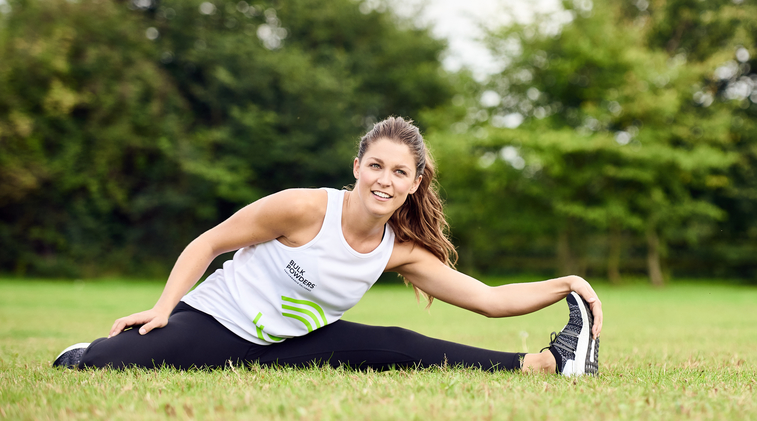As a scientist I am naturally curious – about everything. I ask myself questions some people would find a bit “out there” but hey, it’s in my nature.
I find that if we all understand WHY things happen or HOW things work we will be in a far better place to getting what we want; whether it’s to be stronger, bigger, smaller or… bendier!
Anyone who follows me on Instagram knows I do love a good stretch (“bending over backwards for the likes”… see what I did there? Genius) and so I asked myself “Why do we get more flexible when we stretch and what actually happens?”
So I did what I do best and conducted a 6 month experiment….
Nah, I lie. I Googled.
If you want to know WHY and HOW to get more flexible then this article is for you because what you’ll read might actually surprise you!
Muscle Anatomy 101
Muscles are made up of skeletal muscle tissue (including long, striated units called sarcomeres), blood vessels, tendons, and nerves. Tendons connect bone to muscle and ligaments connect bone to bone – a lot to visualise here, but it’s important! These are called “connective tissues” because they… well, connect things. Scientists are famously unimaginative when it comes to naming things…
A major component of all of these connective tissues is a protein called collagen (it’s not just for ridding the wrinkles!). There are many different types of collagen but with respect to flexibility there are two types with most importance. Type-1 collagen is rigid and strong and usually found in ligaments and tendons. Type-3 collagen is the “stretchier” kind and is also found in these tissues but in lower abundance. Another type of connective tissue found here is Elastin which as you’ve probably guessed from its name is “elastic”.
Most people’s musculoskeletal system is similar in its composition and ratio of collagen and elastin but it is this ratio (partly) that contributes to our flexibility.
Science of Stretching – How does it work?
Modification of Sensation
Admit it; stretching is painful. Pain is a natural reflex system put in place to warn your body of potential danger or harm. When we stretch our bodies just aren’t used to it and send alarm bells ringing.
Interestingly, the more we stretch the less pain we feel – our bodies are getting used to it. Basically, we become “numb” to the pain of stretching.
Elongation
In the mini-anatomy lesson above I mentioned a particular type of tissue called a “sarcomere” found in muscle tissue. These run the length of muscle fibres and as you stretch over time, some muscle tissues physically add more of these sarcomeres to the muscle thereby adding length and increased flexibility to the tissue itself.
It’s all connected
It’s not only your muscle tissue that stretches out – your ligaments and tendons (see, I told you they were important) do, too! It’s thought that these tissues increase their water content which makes them slightly “stretchier” allowing you to go through a deeper stretch.
Changes in physical composition
Okay so this is a very “science-y” paragraph but bear with me…
The act of stretching can activate Stem Cells (kind of like baby muscle and connective tissue cells) which grow up to form more type-3 collagen and elastin cells (remember the stretchy kind?). This increases flexibility not only by adding more length to the muscle but also by changing the physical composition of the muscles and tendons.
A good way to think about this is that your body is adapting to stretching by changing the material the muscles are made of by making the muscle stretchier!
Makes sense, right?
How do I get more flexible?
I wish there was a magical answer for you guys; to gain flexibility without having to stretch (I know most people detest it!) but unfortunately that is the one and only way to increase flexibility.
But! I have good news, too. Turns out you don’t actually need as much as you think.
Studies have shown that the most effective way to increase flexibility within a given muscle is by stretching it (statically – as in, a held stretch) for 45-60 seconds, 6 times a week and for a total of 6 minutes stretching per week.
For example; if you want to increase flexibility in your hamstrings you should perform a static stretch for 45-60 seconds 6 times a week (totalling about 5-6 minutes/week). Voila!
While increasing the time spent stretching the muscle to 7 or 8 minutes per week will result in greater flexibility gains anything beyond 10 minutes per week appears to have no additional impact.
It is also important to note that studies have also shown that it is the FREQUENCY (i.e. stretching 6 or 7 days a week) rather than the DURATION (1 or 2 minutes) that really matters here. So if you’re going to stretch – do it often and not just once a week for a long, painful time.
Take home message
It’s actually really simple! What I tend to do is “sneak” stretches into my day. I might stretch quickly in between sets during training or when I’m waiting on the microwave to “bing” my cereal! Just sneak them in like that and you won’t even notice them but as I’ve mentioned – it is the FREQUENCY that counts.
I’m really stretching myself thin here trying to find a pun to end the article with so I’ll leave it at this; GET TO STRETCHIN’!
Bonus: You’ll be really, really good at Twister.
About the Author
Michelle is a scientist, an athlete and a writer and she’s proud to have faced her demons head on and she’s beating them. In weight lifting she found an outlet to help change her life – and she’s loving it! Follow her journey with BULK POWDERS®.
















